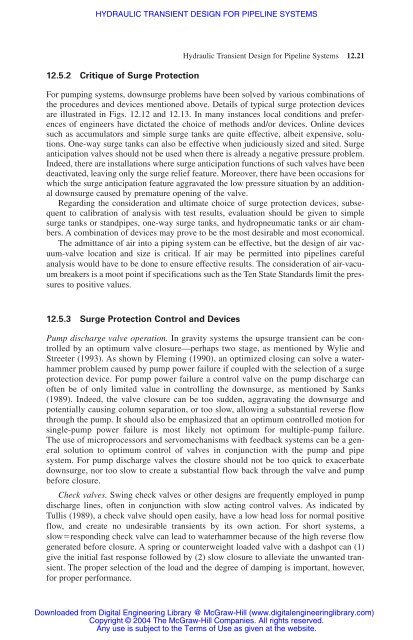chapter 12 hydraulic transient design for pipeline systems
chapter 12 hydraulic transient design for pipeline systems
chapter 12 hydraulic transient design for pipeline systems
Create successful ePaper yourself
Turn your PDF publications into a flip-book with our unique Google optimized e-Paper software.
HYDRAULIC TRANSIENT DESIGN FOR PIPELINE SYSTEMS<br />
<strong>12</strong>.5.2 Critique of Surge Protection<br />
For pumping <strong>systems</strong>, downsurge problems have been solved by various combinations of<br />
the procedures and devices mentioned above. Details of typical surge protection devices<br />
are illustrated in Figs. <strong>12</strong>.<strong>12</strong> and <strong>12</strong>.13. In many instances local conditions and preferences<br />
of engineers have dictated the choice of methods and/or devices. Online devices<br />
such as accumulators and simple surge tanks are quite effective, albeit expensive, solutions.<br />
One-way surge tanks can also be effective when judiciously sized and sited. Surge<br />
anticipation valves should not be used when there is already a negative pressure problem.<br />
Indeed, there are installations where surge anticipation functions of such valves have been<br />
deactivated, leaving only the surge relief feature. Moreover, there have been occasions <strong>for</strong><br />
which the surge anticipation feature aggravated the low pressure situation by an additional<br />
downsurge caused by premature opening of the valve.<br />
Regarding the consideration and ultimate choice of surge protection devices, subsequent<br />
to calibration of analysis with test results, evaluation should be given to simple<br />
surge tanks or standpipes, one-way surge tanks, and hydropneumatic tanks or air chambers.<br />
A combination of devices may prove to be the most desirable and most economical.<br />
The admittance of air into a piping system can be effective, but the <strong>design</strong> of air vacuum-valve<br />
location and size is critical. If air may be permitted into <strong>pipeline</strong>s careful<br />
analysis would have to be done to ensure effective results. The consideration of air-vacuum<br />
breakers is a moot point if specifications such as the Ten State Standards limit the pressures<br />
to positive values.<br />
<strong>12</strong>.5.3 Surge Protection Control and Devices<br />
Hydraulic Transient Design <strong>for</strong> Pipeline Systems <strong>12</strong>.21<br />
Pump discharge valve operation. In gravity <strong>systems</strong> the upsurge <strong>transient</strong> can be controlled<br />
by an optimum valve closure—perhaps two stage, as mentioned by Wylie and<br />
Streeter (1993). As shown by Fleming (1990), an optimized closing can solve a waterhammer<br />
problem caused by pump power failure if coupled with the selection of a surge<br />
protection device. For pump power failure a control valve on the pump discharge can<br />
often be of only limited value in controlling the downsurge, as mentioned by Sanks<br />
(1989). Indeed, the valve closure can be too sudden, aggravating the downsurge and<br />
potentially causing column separation, or too slow, allowing a substantial reverse flow<br />
through the pump. It should also be emphasized that an optimum controlled motion <strong>for</strong><br />
single-pump power failure is most likely not optimum <strong>for</strong> multiple-pump failure.<br />
The use of microprocessors and servomechanisms with feedback <strong>systems</strong> can be a general<br />
solution to optimum control of valves in conjunction with the pump and pipe<br />
system. For pump discharge valves the closure should not be too quick to exacerbate<br />
downsurge, nor too slow to create a substantial flow back through the valve and pump<br />
be<strong>for</strong>e closure.<br />
Check valves. Swing check valves or other <strong>design</strong>s are frequently employed in pump<br />
discharge lines, often in conjunction with slow acting control valves. As indicated by<br />
Tullis (1989), a check valve should open easily, have a low head loss <strong>for</strong> normal positive<br />
flow, and create no undesirable <strong>transient</strong>s by its own action. For short <strong>systems</strong>, a<br />
slow�responding check valve can lead to waterhammer because of the high reverse flow<br />
generated be<strong>for</strong>e closure. A spring or counterweight loaded valve with a dashpot can (1)<br />
give the initial fast response followed by (2) slow closure to alleviate the unwanted <strong>transient</strong>.<br />
The proper selection of the load and the degree of damping is important, however,<br />
<strong>for</strong> proper per<strong>for</strong>mance.<br />
Downloaded from Digital Engineering Library @ McGraw-Hill (www.digitalengineeringlibrary.com)<br />
Copyright © 2004 The McGraw-Hill Companies. All rights reserved.<br />
Any use is subject to the Terms of Use as given at the website.
















